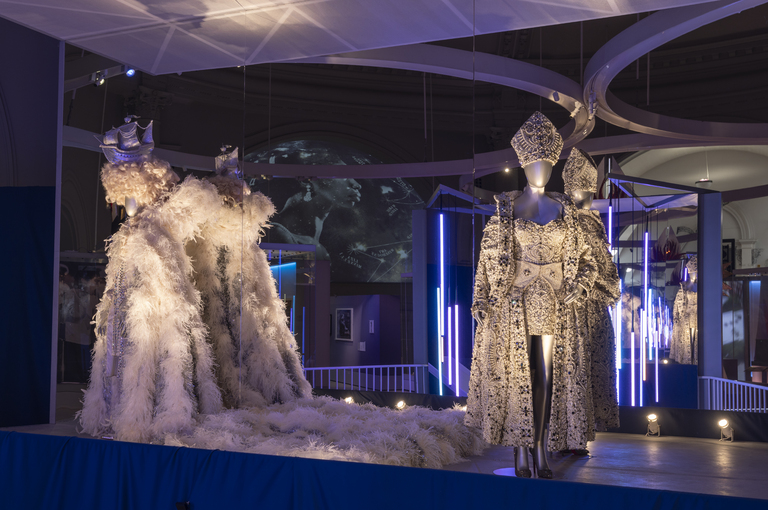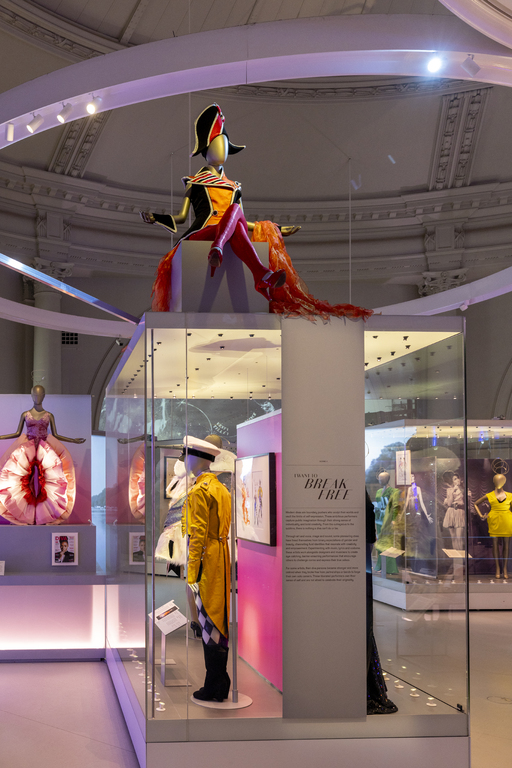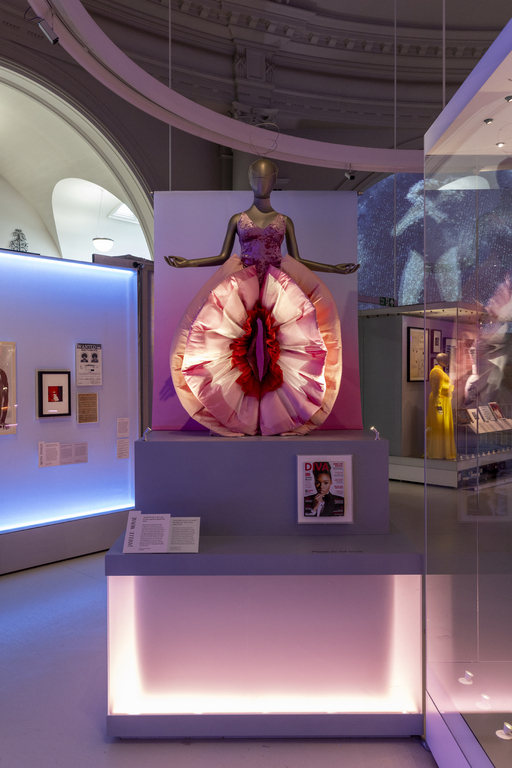DIVA
DIVA is the first exhibition of its kind to celebrate the extraordinary power and creativity of iconic performers who have made their voices heard from the 19th century to today.
The exhibition will showcase over 250 objects drawn from the V&A collection and loans from across the world, spanning fashion, photography, design, costumes, music, and live performance. Through theatrical staging and a sonic headset experience, DIVA will celebrate the powerful and personal stories of creativity, ambition, and resilience of some the best known divas, from opera goddesses and silent movie stars to sirens of the big screen and today’s global megastars. The exhibition also looks at how the performer has intersected with society and driven change through their platform and profile for social good and political change, including global civil rights and feminism.
DIVA will demonstrate the phenomenal ability of the diva to transform, inspire and embrace the external and internal forces that contribute to defining, shaping, and worshipping a diva. Delving into the origins of the term ‘diva’ – meaning goddess in Italian – the exhibition will explore how the meaning of the word has been subverted and embraced over time, and how the label has been reclaimed by performers, their fans and wider society.
Over 60 looks will go on display, many rare or on display for the first time, including: a stage ensemble worn by Maria Callas as Norma in the Covent Garden Opera Company production of ‘Norma’ (1952); the fringed black dress worn by Marilyn Monroe as Sugar “Kane” Kowalczyk in ‘Some Like it Hot’ (1959); the only known surviving dress worn by Clara Bow, rarely seen outside of the U.S; iconic costumes designed by fashion designer for the stars Bob Mackie, including looks worn by Tina Turner, P!nk and CHER; a Louis XIV inspired look, with towering powdered wig and train worn by Elton John for his 50th birthday celebration, designed by Sandy Powell; Shirley Bassey’s couture pink gown designed by Julien MacDonald including diamanté-studded wellington boots, worn on stage at Glastonbury (2007); and Janelle Monae’s ‘vulva pants’ designed by Duran Lantink for the music video ‘Pynk’ (2018). Also on display will be examples of ephemera for the divadom including posters, song sheets and handwritten lyric sheets as well as personal objects and accessories owned by divas. DIVA also includes examples of diva branding, highlighting the entrepreneurial and enterprising spirit of these divas, as well key photographic works by photographers including Sheila Rock, David Corio and Nick Knight. Finally, a video wall will celebrate the art of drag and its relationship to the diva.
About the Exhibition:
‘Act One’ provides historical context to the creation of the Diva and explores the goddesses of the stage and screen who have endured and shaped our popular culture today. This section celebrates how the first opera divas Adelina Patti and Jenny Lind created and performed extraordinary roles which brought them wealth and recognition at a time when most women were unable to pursue an education or careers. This section will also explore how actors such as Ellen Terry, Sarah Bernhardt and Marie Lloyd drove the first wave of feminism and how the powerful women of the 20th-century built on this struggle for equality, including silent-screen sirens Clara Bow and Mary Pickford and Golden Age of Hollywood stars Vivien Leigh, Mae West and Marilyn Monroe. Also explored in this section is the impact of cult status, and the role of studios and the press in fueling public interest in the diva’s personal lives.
Key highlights in this section include: early Parisian couture worn by Adelina Patti from the V&A’s collection, on display for the first time; a jewellery box embellished with mother of pearl inlay, presented to Jenny Lind after a charity concert in aid of the Queen’s College Hospital, Birmingham (1848); an ensemble worn by prima ballerina Tamara Karsavina as Salomé in ‘La Tragédie de Salomé’, performed by Serge Diaghilev’s Ballets Russes (1913); powerful objects including a couture gown, on loan from Josephine Baker’s former home in France – Château de Milandes – will reveal her ground-breaking career, from performer to activist; Margot Channing’s party dress from ‘All About Eve’ (1950), performed by Bette Davis, designed by iconic costume designer Edith Head; a corseted crimson dress designed by Christian Dior and worn by Vivien Leigh as Paola in ‘Duel of Angels’ by Jean Giraudoux’s play at the Apollo Theatre (1958); costumes from Hollywood, including a silk chiffon and sequin dress worn by Mae West as lion tamer Tira in ‘I’m No Angel’ (1933); the sleek black fringed dress worn by Marilyn Monroe as the character Sugar “Kane” Kowalczyk in ‘Some Like it Hot’ (1959); and a sensual beaded ensemble worn by Theda Bara for lost film ‘Cleopatra’, dir. J. Gordon Edwards (1917).
The finale of ‘Act One’ showcases the timeless opera diva, and will include costumes worn by Maria Callas from her the very first and last performances at The Royal Opera House; as Norma in the Covent Garden Opera Company production of ‘Norma’ (1952) and the legendary ‘Tosca’ directed by Franco Zeffirelli (1964), Joyce DiDonato’s custom red satin dress by Vivienne Westwood (2012) and a grey chiffon dress and turban decorated with diamanté, worn by Jessye Norman as Ariadne in The Royal Opera House production of ‘Ariadne auf Naxos’ (1985).
‘Act Two’ celebrates the diva today and explores how performers of all genders have redefined and reclaimed the title ‘diva’ as an expression of their art, voice, and sense of self. It will interrogate divas navigating the historically male-dominated music and film businesses; those who have expanded their affairs into the worlds of business, and the phenomenon of the diva brand through artists such as Rihanna, Dolly Parton and Barbra Streisand. It will explore how the modern performer continues to use their voice to enable social and political change, and how artists such as Billie Holliday, Nina Simone and Ella Fitzgerald endured backlash, criticism and danger to oppose the status quo, and how Aretha Franklin’s anthem ‘Respect’ (1967) became an anthem of women’s empowerment and the US Civil Rights Movement. The section will feature boundary-pushing divas such as Grace Jones, Annie Lennox, Prince and Elton John, and how they have emancipated themselves from the limitations of traditional representation, using costume, androgyny and performance style as tools through which to express relationships with sexuality, gender and the body. It will reveal how divas like Bjork are unafraid to transform and reinvent themselves and how divas like Siouxsie Sioux and Missy Elliott shifted the diva needle into new genres. How the modern diva navigates the cult of celebrity, the media eye, and the struggle between personal and private life will also be examined. Finally, this Act considers how performing the diva requires exceptional talent, dedication and the pursuit of perfection and how legendary divas CHER and Tina Turner have collaborated with visionary fashion designer Bob Mackie to construct their full glam, high camp stage personas and how that has inspired the divas of drag, such as Ru Paul.
Highlights from Act Two include; Edith Piaf’s instantly recognisable little black dress (1950s); several iconic costumes worn by CHER across the decades, including a glittering two-piece ensemble, worn to the 1975 Rock Music Awards, designed by Bob Mackie; Tina Turner’s iconic ‘Flame Dress’ (1977), also designed by Mackie; an acid yellow and pink mini dress worn by Debbie Harry on Blondie’s 1979 European tour; a Louis XIV inspired look, with towering powdered wig and train worn by Elton John for his 50th birthday celebration (1997), designed by Sandy Powell; Shirley Bassey’s couture pink gown designed by Julien MacDonald, with diamanté-studded wellington boots, worn to Glastonbury (2007); and ‘Vulva pants’ designed by Duran Lantink for Janelle Monae’s music video ‘Pynk’ (2018).


